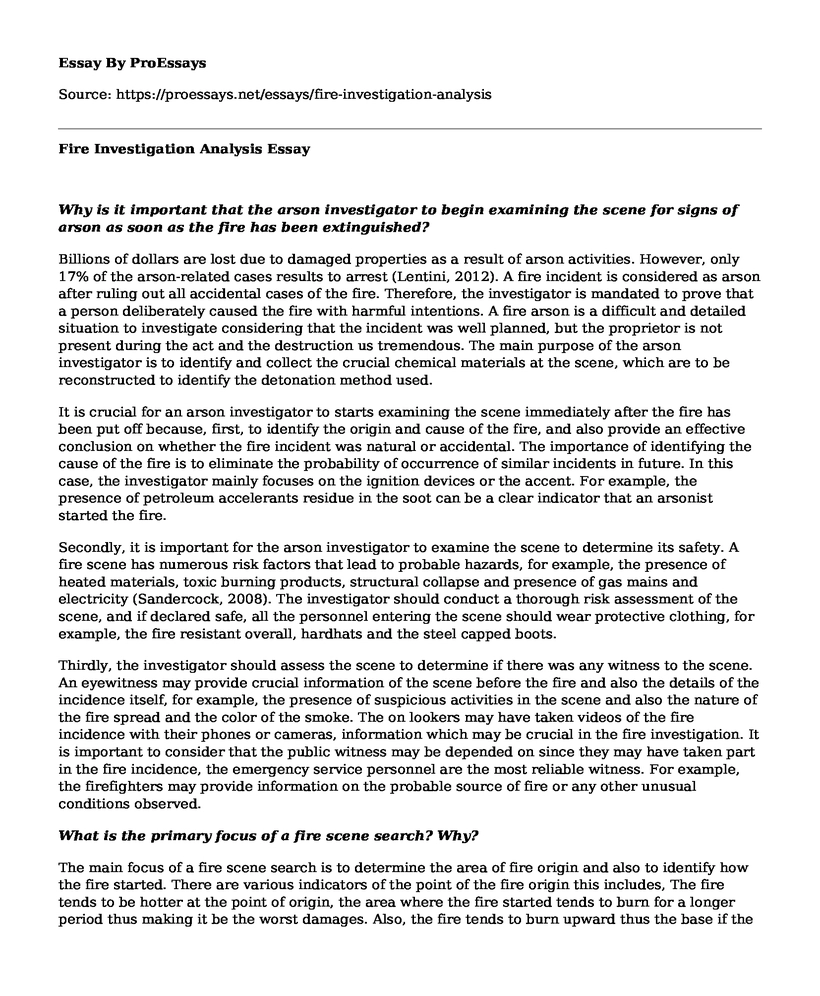Why is it important that the arson investigator to begin examining the scene for signs of arson as soon as the fire has been extinguished?
Billions of dollars are lost due to damaged properties as a result of arson activities. However, only 17% of the arson-related cases results to arrest (Lentini, 2012). A fire incident is considered as arson after ruling out all accidental cases of the fire. Therefore, the investigator is mandated to prove that a person deliberately caused the fire with harmful intentions. A fire arson is a difficult and detailed situation to investigate considering that the incident was well planned, but the proprietor is not present during the act and the destruction us tremendous. The main purpose of the arson investigator is to identify and collect the crucial chemical materials at the scene, which are to be reconstructed to identify the detonation method used.
It is crucial for an arson investigator to starts examining the scene immediately after the fire has been put off because, first, to identify the origin and cause of the fire, and also provide an effective conclusion on whether the fire incident was natural or accidental. The importance of identifying the cause of the fire is to eliminate the probability of occurrence of similar incidents in future. In this case, the investigator mainly focuses on the ignition devices or the accent. For example, the presence of petroleum accelerants residue in the soot can be a clear indicator that an arsonist started the fire.
Secondly, it is important for the arson investigator to examine the scene to determine its safety. A fire scene has numerous risk factors that lead to probable hazards, for example, the presence of heated materials, toxic burning products, structural collapse and presence of gas mains and electricity (Sandercock, 2008). The investigator should conduct a thorough risk assessment of the scene, and if declared safe, all the personnel entering the scene should wear protective clothing, for example, the fire resistant overall, hardhats and the steel capped boots.
Thirdly, the investigator should assess the scene to determine if there was any witness to the scene. An eyewitness may provide crucial information of the scene before the fire and also the details of the incidence itself, for example, the presence of suspicious activities in the scene and also the nature of the fire spread and the color of the smoke. The on lookers may have taken videos of the fire incidence with their phones or cameras, information which may be crucial in the fire investigation. It is important to consider that the public witness may be depended on since they may have taken part in the fire incidence, the emergency service personnel are the most reliable witness. For example, the firefighters may provide information on the probable source of fire or any other unusual conditions observed.
What is the primary focus of a fire scene search? Why?
The main focus of a fire scene search is to determine the area of fire origin and also to identify how the fire started. There are various indicators of the point of the fire origin this includes, The fire tends to be hotter at the point of origin, the area where the fire started tends to burn for a longer period thus making it be the worst damages. Also, the fire tends to burn upward thus the base if the fire is expected to be at a lower point of burn. The structural damages may also act as a good indicator of the origin of the fire since most buildings collapse in a way that the point first affected by the fire is clear. These factors of a primary scene search help to identify if the fire incident was natural or accidental to prevent the occurrence of such a case in the future.
What evidence at the fire scene may indicate the possibility of arson?
There is a wide variety of indicators of a deliberate fire ignition or arson this includes, the presence of signs of forced entry into a facility suggests arson, this is mainly identified through the presence of broken windows, forced doors, and disabled intruder alarms. Secondly is the presence of flammable liquids in the premises such as petrol or kerosene that are used by the arsons to accelerate the fire. The use of the flammable liquids can be detected using sniffer dogs to identify the presence of hydrocarbon in the scene (Sandercock, 2008).
References
Lentini, J. J. (2012). Scientific protocols for fire investigation. CRC press.
Sandercock, P. M. L. (2008). Fire investigation and ignitable liquid residue analysis-a review: 2001-2007. Forensic science international, 176(2-3), 93-110.
Cite this page
Fire Investigation Analysis. (2022, May 12). Retrieved from https://proessays.net/essays/fire-investigation-analysis
If you are the original author of this essay and no longer wish to have it published on the ProEssays website, please click below to request its removal:
- Police Culture, Personality and Stress Essay Example
- Cook County Fire and Cocoanut Grove Nightclub Fire Paper Example
- UAE Changes in Transportation Before 60 Years Paper Example
- Essay Example on Real Estate Sec. Market: 20 Yrs of Growth & Risk Impact
- Essay Example on Be a Police Officer: A Job of Authority and Fear
- Analysis of Police Officer and Firefighter Salaries - Essay Sample
- Plan of Action to Maintain Law & Order: A Global Perspective - Essay Sample







